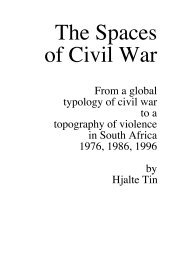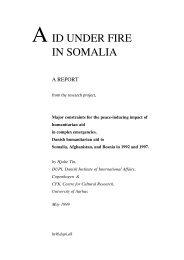wfp, food aid and local survival in guinea-bissau, 1998-99 - Nina ...
wfp, food aid and local survival in guinea-bissau, 1998-99 - Nina ...
wfp, food aid and local survival in guinea-bissau, 1998-99 - Nina ...
Create successful ePaper yourself
Turn your PDF publications into a flip-book with our unique Google optimized e-Paper software.
Hjalte T<strong>in</strong> : Food Aid <strong>in</strong> Gu<strong>in</strong>ea-Bissau <strong>1<strong>99</strong>8</strong>-<strong>99</strong>. June 2001 ; page 5<br />
In the early hours of Sunday June 7, <strong>1<strong>99</strong>8</strong> army units under Brigadier Ansumane Mané<br />
began an armed upris<strong>in</strong>g aga<strong>in</strong>st President N<strong>in</strong>o Veira. The response by the government<br />
was an attempt to rega<strong>in</strong> control of the national territory by force. The Junta Militar did<br />
not back down, <strong>and</strong> thus the coup grew <strong>in</strong>to a civil war. A conflict with<strong>in</strong> the powerelite<br />
became a national emergency when hundreds of thous<strong>and</strong>s fled their homes <strong>in</strong><br />
Bissau. The humanitarian response was always subject to the dem<strong>and</strong>s of the military<br />
struggle. This was the case both of the National Government, the Junta Militar <strong>and</strong> the<br />
key external actors such as the Senegalese Government. Neither the national<br />
government nor the Junta Militar spent any money on humanitarian assistance to their<br />
own population, while they bought weapons for a large, but unknown amount of<br />
money-<strong>and</strong> they cont<strong>in</strong>ued the conflict until its ultimate violent resolution.<br />
Dur<strong>in</strong>g the first 72 hours 1.300 Senegalese <strong>and</strong> 400 Gu<strong>in</strong>ea-Conakry troops <strong>in</strong>tervened<br />
on the President’s side. A few days later the Junta Militar took control of the Army’s<br />
ma<strong>in</strong> depot <strong>and</strong> the <strong>in</strong>ternational airport cutt<strong>in</strong>g off Bissau from the rest of the country.<br />
WFP <strong>and</strong> all other UN <strong>in</strong>ternational staff was evacuated from Bissau. With heavy<br />
weapons deployed on both sides civilian damage was <strong>in</strong>creas<strong>in</strong>gly <strong>in</strong>flicted <strong>and</strong> almost<br />
all of its 300.000 <strong>in</strong>habitants fled. Fight<strong>in</strong>g cont<strong>in</strong>ued until July 26, when a ceasefire<br />
agreement was brokered, leav<strong>in</strong>g the government <strong>in</strong> control of Bissau, a few<br />
prov<strong>in</strong>sional towns <strong>and</strong> the Bijagos Isl<strong>and</strong>s. The follow<strong>in</strong>g month perhaps 2/3 of<br />
Bissau’s <strong>in</strong>ternally displaced <strong>in</strong>habitants return to the capital. WFP established a small<br />
office <strong>in</strong> Bafata, while no staff was allowed to go back to Bissau.<br />
Fight<strong>in</strong>g broke out on October 18 for a week. Many people fled Bissau for a second<br />
time. On October 21-22 the Junta Militar took control of Bafata <strong>and</strong> Gabu <strong>in</strong>l<strong>and</strong> <strong>and</strong><br />
Prabis just outside Bissau. Viera’s forces was reduced to a Presidential Guard of 400<br />
men. 2.500 Senegalese <strong>and</strong> 400 Conakry troops helped him hang on to Bissau <strong>and</strong> the<br />
Bijagos isl<strong>and</strong>s. October 26 a new cease-fire was brokered <strong>and</strong> on November 1 N<strong>in</strong>o






